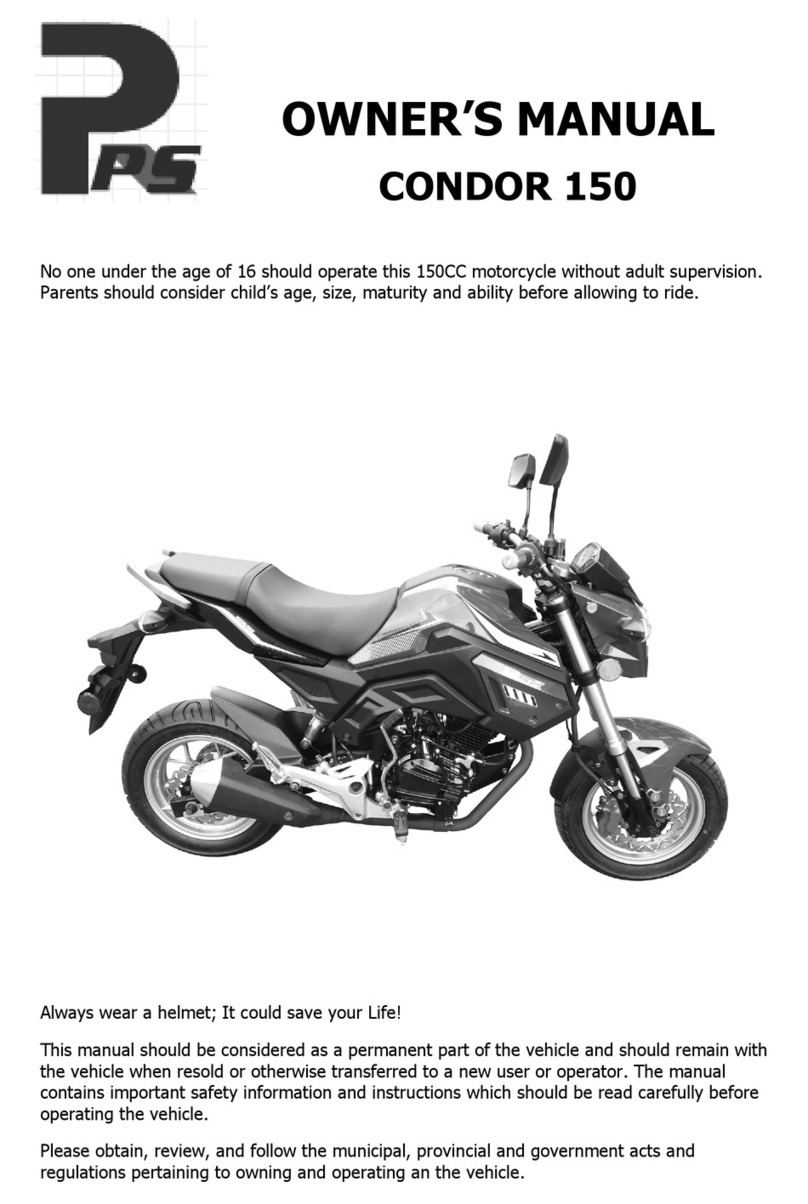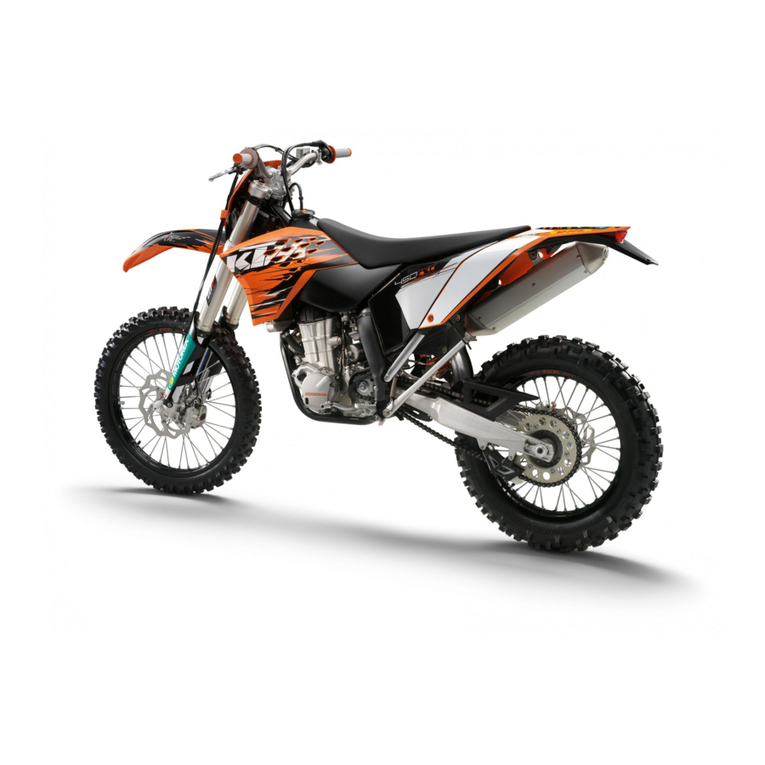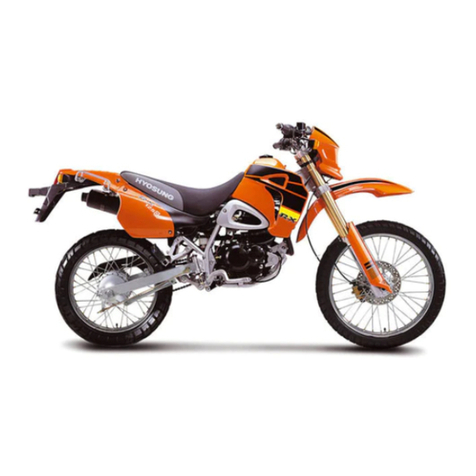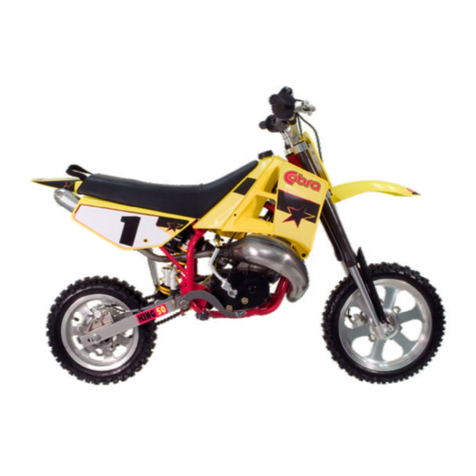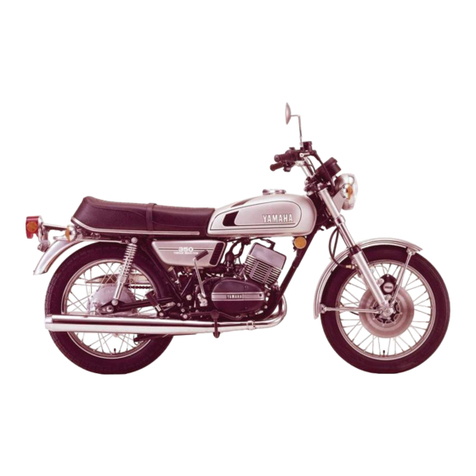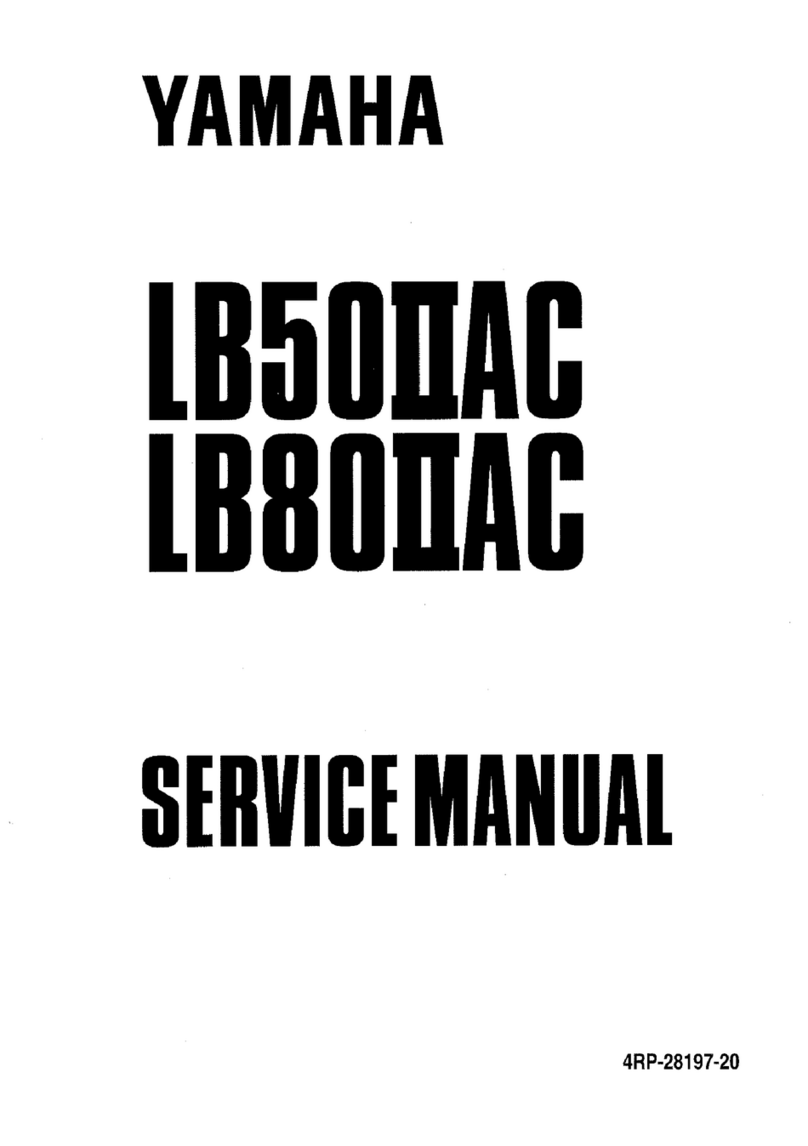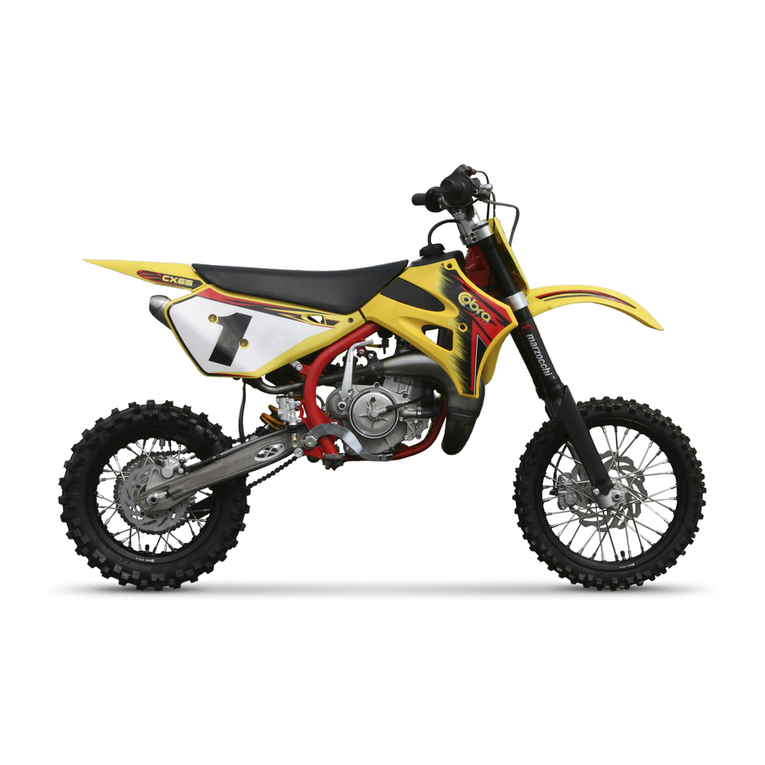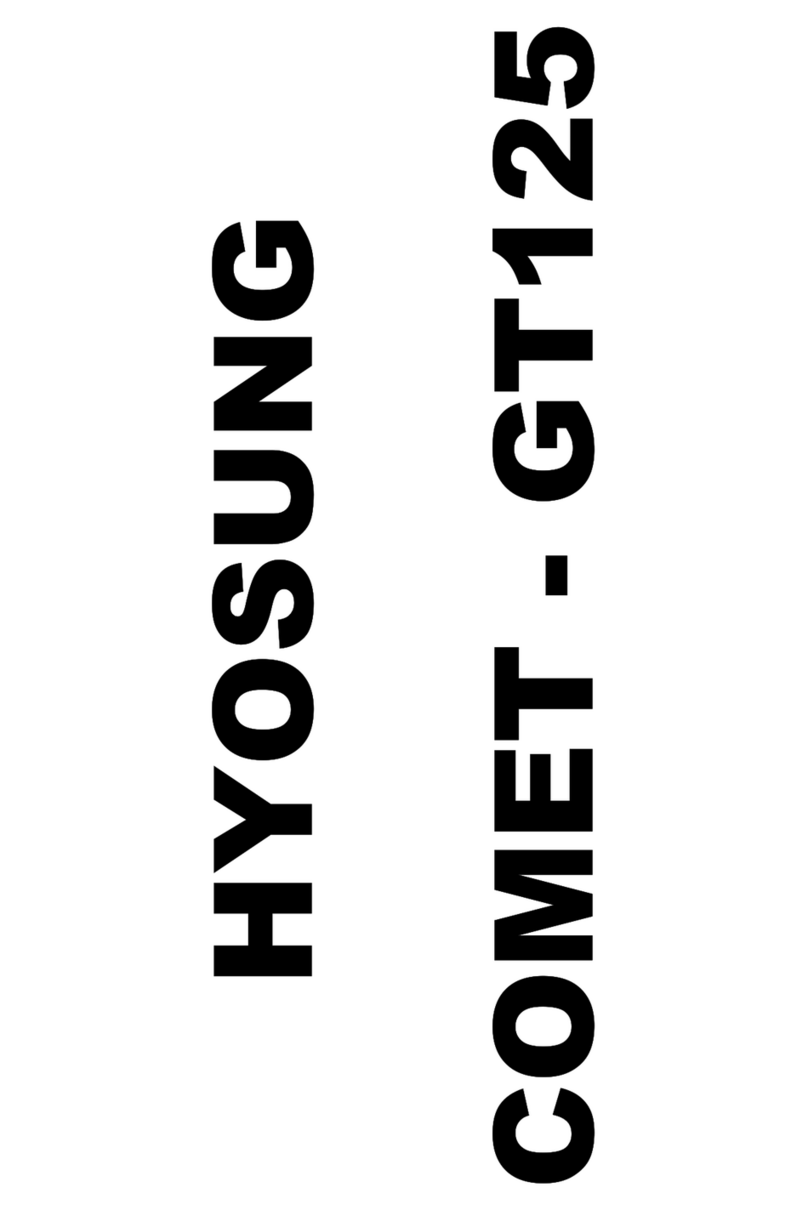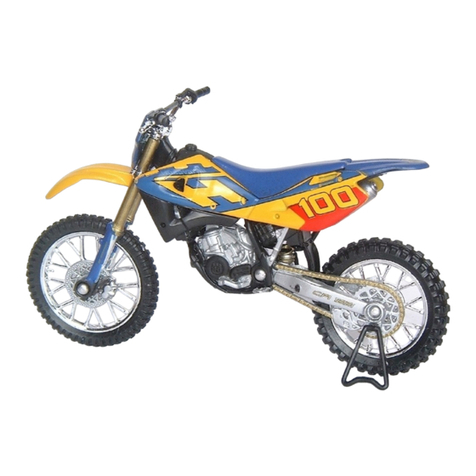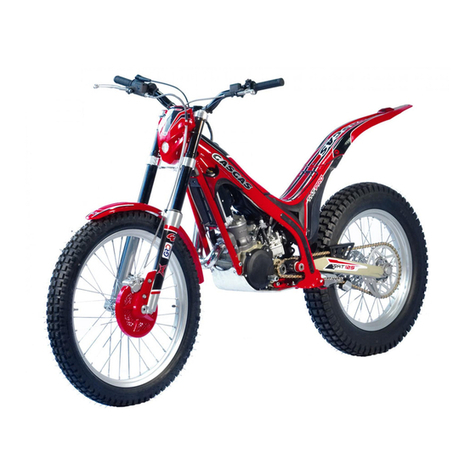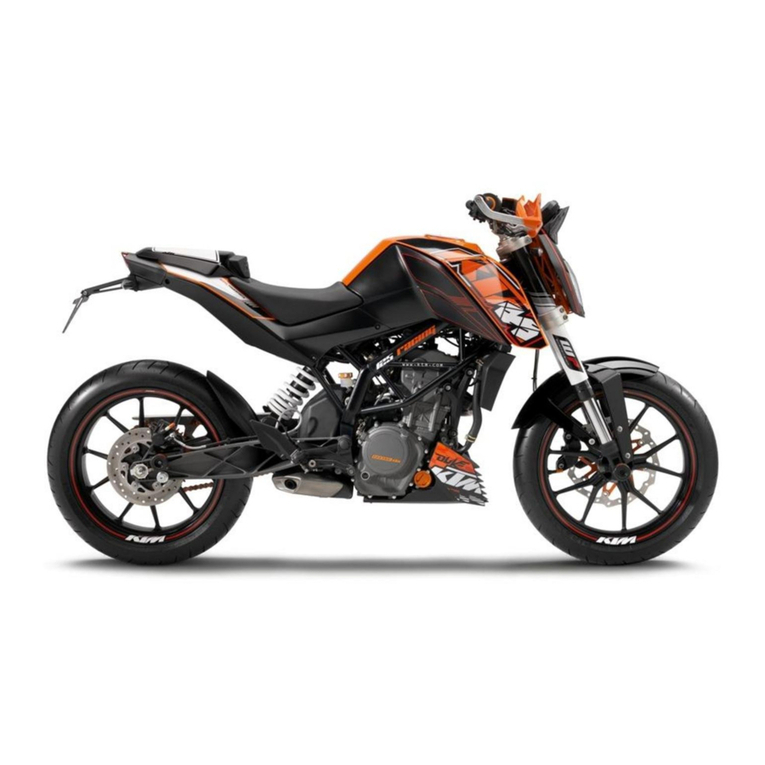PS Hawk DLX EFI User manual

OWNER’S MANUAL
Hawk DLX EFI Motorcycle
Minimum age requirement: 16
Always wear a helmet; It could save your Life!
This manual should be considered as a permanent part of the vehicle and
should remain with the vehicle when resold or otherwise transferred to a
new user or operator. The manual contains important safety information
and instructions which should be read carefully before operating the
vehicle.

II
INTRODUCTION
Congratulations on your purchase of the Ricky Power Sports LLC’250cc Hawk DLX
EFI motorcycle.
Take time to understand how your motorcycle works before riding. Scheduled service
is a must and it is important to follow the break-in guidelines and pre-ride
instructions.
Make certain that you read the warranty coverage information provided and
understand your responsibilities.
If you have any questions, comment or concerns contact Ricky Power Sports, LLC at
1-844-250-2199. All information, illustrations, photographs and specifications
contained in this manual are based on the latest product information available at the
time of publication. Due to improvements or other changes, there will be some
discrepancies in this manual. We reserve the right to make product changes at any
time, without notice and without incurring any obligation to make the same or similar
changes to the vehicle previously built or sold.
SAFETY
The most important thing to remember is your safety and the safety of others. We
have included procedures and labels to help you make safe informed decisions. This
information is provided to make you aware of potential hazards that could hurt you
and/or others. It is impossible to warn you of ALL potential hazards so you must use
your own best judgment. The following are different kinds of safety information you
will find in this manual:
Safety Labels - On your motorcycle
Safety Messages - Warning, Caution and Danger
The meaning of Warning, Caution and Danger Safety Messages:
Death or serious injury CAN occur if proper instructions are not followed.
Death or serious injury WILL occur if proper instructions are not followed.
You CAN be hurt if proper instructions are not followed.

III
CONTENTS
Warranty ........................................................................................................... 1
Safety Information.............................................................................................. 2
TAKE TIME TO LEARN AND PRACTICE.................................................................. 2
RIDE DEFENSIVELY ............................................................................................ 2
Safety Labels...................................................................................................... 3
Components Locations ........................................................................................ 4
Indicators .......................................................................................................... 5
Controls............................................................................................................. 6
Before Riding ..................................................................................................... 8
Pre-Ride Inspection ............................................................................................ 9
Loading guidelines and load limits...................................................................... 10
Starting procedures .......................................................................................... 11
Starting and Stopping the Engine, Shifting Gears................................................. 12
Braking............................................................................................................ 13
Parking ............................................................................................................ 13
Servicing your motorcycle.................................................................................. 14
Maintenance Safety .......................................................................................... 15
Maintenance Records ........................................................................................ 17
Tool kit and Owner’s manual storage.................................................................. 18
Fuel and Engine Oil........................................................................................... 19
Engine Oil ........................................................................................................ 20
Air Cleaner ....................................................................................................... 22
Crankcase Breather and Throttle........................................................................ 23
Throttle Inspection ........................................................................................... 24
Clutch System .................................................................................................. 25
Engine Idle Speed............................................................................................. 25
Spark Plug ....................................................................................................... 26
Suspension ...................................................................................................... 26
Brakes ............................................................................................................. 27
Other Inspections ............................................................................................. 27
Tires and Tube Repair....................................................................................... 29
Drive Chain ...................................................................................................... 30
Lubrication....................................................................................................... 32
Battery ............................................................................................................ 32
Appearance Care .............................................................................................. 34
Vehicle Identification......................................................................................... 35
Specifications ................................................................................................... 36
Wire Diagram ................................................................................................... 37
HMC-Emission Control System Warranty Statement ............................................. 39

1
WARRANTY
Congratulations on your purchase of the Ricky Power Sports, LLC’250cc Hawk DLX
EFI motorcycle.
It is warranted to be free of manufacturing defects in the material of workmanship
for a period of 90 days from the date of purchase. During the warranty period Ricky
Power Sports, LLC will at its option repair, provide replacement parts or replace your
250cc Hawk DLX EFI motorcycle at no charge. This warranty does not cover normal
wear items or damage caused by neglect or misuse of the product.
Engine Warranty - 90 days
Frame Warranty - 90 days
Warranty is void if:
Frame is bent or broken due to abuse.
Wheels are bent or broken.
Fender bent of broken due to abuse.
Any sign of impact, accident, jumping, spin-outs or roll over.
Ricky Power Sports, LLC is not liable for any damage claim or liability claim person or
otherwise resulting from the operation of this product in any way.
Should you experience a problem or need to return your motorcycle for repair,
please call the Ricky Power Sports, LLC customer service department TOLL FREE at
1-844-250-2199. You will be instructed how to proceed.
A COPY OF THE SALE RECEIPT IS REQUIRED.

2
SAFETY INFORMATION
This user’s manual contains important safety and maintenance information. Read it
carefully before riding. Failure to follow the warnings contained in this manual could
result in INJURY or DEATH.
ALWAYS WEAR A HELMET
The operator and passenger (if any) of this vehicle should always wear a helmet
approved by agencies such as the Department of Transportation (DOT), Safety
Helmet Council of America (SHCA), or Snell Memorial Foundation (SNELL). Most
accident fatalities are due to head injuries. The operator should also wear face
shields or goggles, boots or closed-toe shoes, gloves and other appropriate
protective clothing.
TAKE TIME TO LEARN AND PRACTICE
Take time to get to know this vehicle. The operator’s ability to operate this
motorcycle safely is largely dependent upon the operator’s ability to exercise proper
judgment. The operator must be of sufficient age, understanding, mental capacity,
and physical capability to safely operate this vehicle. This vehicle should only be
operated after sufficient practice in a decongested area. Safe operation includes
responsibility for the safety of a passenger (if any). We recommend that any
inexperienced driver should take a certified course approved by the Motorcycle
Safety Foundation (MSF).
RIDE DEFENSIVELY
A common accident happens when a car suddenly moves into your lane. Most
motorcycle collisions happen when a car turns left in front of a motorcycle. Pay extra
attention to other vehicles around you and never expect that they can see you.
MAKE YOURSELF VISIBLE
Make yourself more visible by wearing bright reflective clothing. Use your horn when
it helps others see you and before turning use your turn signal.
RIDE WITHIN YOUR LIMITS
You should not ride beyond your abilities and never faster than the posted speed
limit. NEVER OPERATE THIS VEHICLE WHILE UNDER THE INFLUENCE OF ALCOHOL,
DRUGS OR MEDICATION OF ANY KIND. SUCH OPERATION COULD BE DANGEROUS
TO YOURSELF AND/OR OTHERS.
KEEP YOUR VEHICLE IN A SAFE CONDITION
Proper maintenance will ensure a safe ride. Perform all recommended maintenance
and inspect your vehicle before each ride. Never modify your vehicle in any way to
make it unsafe.

3
SAFETY LABELS
The safety labels on your motorcycle provide you with important information do not
remove them.
If a label becomes too difficult to read or comes off, please contact Ricky Power
Sports, LLC for replacements.

4
COMPONENTS LOCATIONS

5
INDICATORS
The indicators on your motorcycle help make you aware of possible issues, refer to
them often.
Speedometer - Shows the speed you are traveling miles per hour.
Odometer - Tracks the total miles driven.
Trip meter - Tracks the total miles driven on your trip.
High beam indicator - Illuminates when high beam lights are on.
Turn signal indicator - Flashes when left/right turn signal is on.
Neutral indicator - Illuminates when transmission is in neutral.
Oil level indicator - Flashes when oil is low.
Troubles indicator –Displays when troubles are happened.

6
CONTROLS
FUEL VALVE
Fuel valve-Used to control the flow of gasoline from the fuel tank to the fuel nozzle.
ON - Gasoline can flow to the fuel nozzle.
OFF -Gasoline cannot flow to the fuel nozzle.
RES- Gasoline can flow to the fuel nozzle when you have run out of gas in the gas
tank.
Make sure to refuel as soon as possible.

7
IGNITION SWITCH
Ignition switch-used for starting and stopping
the engine. The key is used to lock the
steering, preventing theft.
ON-ALL electrical components are ON.
Off-ALL electrical components are OFF.
START BUTTON AND ENGINE STOP SWITCH
Start button - Pushing the start button will start
the engine. When button is pressed in the start
motor will crank the engine, See starting
procedures.
Engine stop switch- In case of an emergency and a
quick stop is necessary turn switch to the “OFF”
position. This switch must be in the “RUN” position
in order to start the vehicle, and should remain in
this position even while the engine is off. If you
leave ignition switch on and engine stop switch off,
the lights will stay on, causing the battery to lose life.
RUN OFF
HEADLIGHT DIMMER SWITCH, TURN SIGNAL SWITCH AND HORN
Turn signal switch - Use this switch to signal a lane change or turn.
Left Right
Horn –The horn is used to warn other
motorist.
Headlight dimmer switch –This switch is used
to change from “HI”to “LO”beam.
- HI - LO

8
BEFORE RIDING
Before your first ride on your new motorcycle we strongly recommend you:
Read the owner’s manual.
Understand all safety labels.
Know how to operate all controls.
Before you ride each time, make sure:
You are in good physical and mental health.
You are wearing protective gear (helmet, clothing, eye protection etc.) If you
have a passenger, be sure also having protective wears for passenger.
You do not have ANY alcohol or drugs in your system.
Protective Clothing
For your protection we urge you to ALWAYS wear protective clothing. The proper
clothes can protect you from injury. Wear an approved motorcycle helmet, goggles,
a good pair of gloves, strong boots that cover the ankle, long pants, and a long
sleeve shirt every time you ride.
Helmets and Eye protection
A DOT approved motorcycle helmet is the most important part of your protective
gear. A DOT approved motorcycle helmet can help prevent a serious head injury.
Choose a helmet that fits snug. Motorcycle dealers can help in selecting a good
quality helmet which fits properly.
Not wearing a helmet greatly increases your chances of serious head injuries or
death in the event of an accident.
If you are riding with a passenger be sure they are also wearing a helmet and eye
protection.

9
PRE-RIDE INSPECTION
Before each ride check the condition of your motorcycle to make sure that it does
not have mechanical problems. Your motorcycle should always be in good riding
condition to ensure the safety of you, your passenger (if any) and others around you.
Improper maintenance of this motorcycle or failure to correct any problems can
result in serious injury or death. ALWAYS perform aa pre-ride inspection before
every ride.
Be sure to check the following items before each ride:
BRAKES - Press on the brake pedal and hold in brake lever to ensure that the
brakes are operating correctly.
THROTTLE - Rotate the throttle handle to ensure it moves smoothly.
LEAKS and LOOSE ENDS - Check all hoses for leaks and cables that may be loose.
LIGHTS - Be sure that your headlight, tail light, brake light and turn signals are
working properly.
CHAIN - Check the condition. Adjust the slack (if any) and lubricate (if needed).
TIRES - Use an air pressure gauge to check the pressure. If needed add air. Look
for excessive wear or damage.
If you are riding with a passenger or carrying cargo check:
LOAD LIMIT - Do not exceed the load limit.
CARGO - Secure all cargo.
REAR SUSPENSION - Adjust the suspension according to the weight of the load
you are carrying.
Make certain that you keep with the Periodic maintenance (see periodic maintenance
section).

10
LOADING GUIDELINES AND LOAD LIMITS
Your motorcycle has been designed to carry you and one passenger. When a
passenger is riding with you there will be a difference in the acceleration and braking.
Load Limits
Maximum weight capacity (including rider, passenger, accessories and cargo): 331
lbs (150kg)
Maximum cargo weight: 25lbs (10kg)
Loading guidelines
Improper loading or overloading can be hazardous and may cause an accident
resulting in serious injury or death. Follow all load limits.
Improper loading of your motorcycle may affect your stability. With the motorcycle
properly loaded always ride at a reduced speed.
If you have questions about carrying cargo contact Ricky Power Sports LLC. for
advice.
Check the following when carrying a passenger or cargo:
Both tires are properly inflated.
Rear suspension may need adjusting.
Secure all cargo.
Balance cargo weight
● Do not attach large or heavy items to the front of your motorcycle.
Starting and Stopping the Engine
Always follow proper starting procedures.
Never start the engine in a closed place as the exhausted gas form the vehicle
contains toxic carbon monoxide.

11
STARTING PROCEDURES
Insert key hexagon into the groove turning anti-clockwise to “OPEN”。
Insert key into ignition, turn to “ON”position.
Make sure the transmission is in the “NEUTRAL”position.
Turn the engine stop switch to “RUN”.
If you are restarting a warm engine, follow procedure for High Air Temperature.
Normal Air Temperature: 10º-35ºC (50º-95ºF)
Starting and Stopping the Engine
High Air Temperature: 35ºC (95ºF) or above
1) Slightly open throttle
2) Start engine
Low Air Temperature: 10ºC (50ºF) or below
1) Follow Normal Air Temperature procedures 1-2.
2) RPM is automatically adjusted by ECU.
3) Keep warming the engine until it responds to the throttle.
NOTICE:
Fast idling for more than 5 minutes at Normal Air Temperature can cause exhaust
pipe discoloration.
Flooded Engine
The engine may be flooded with extra gasoline, if it does not start after several
attempts. Try the following to clear a flooded engine:
1) Turn the engine stop switch to the “OFF”position.
2) Open the throttle completely.
3) Push and hold in the start button for 5 seconds.
4) Wait 10 seconds and turn the engine stop switch to the “RUN”position.
Next, follow the High Air Temperature starting procedures.

12
STARTING AND STOPPING THE ENGINE, SHIFTING GEARS
How to stop the engine
Normal Engine Stop
Shift into neutral and turn the ignition switch “OFF”.
DO NOT leave the ignition switch “ON”while the engine stop switch if “OFF”,
this will allow the lights to stay “ON”causing the battery to lose life.
Emergency Engine Stop
If an emergency stop is necessary, use the engine stop switch. Simply press the
emergency stop switch to “OFF”.
Shifting Gears
Your motorcycle is equipped with a cable-operated
clutch. It has five forward gears, one down and four up.
Tips for learning how to shift for the inexperienced rider:
Shift while moving a straight line.
Let loose on the throttle and pull in clutch lever
completely before shifting (improper shifting may cause damage to the engine).
Recognize the engaging point when you release the clutch lever.
Tips for learning how to shift for the inexperienced rider (continued):
Reduce the throttle or shift to a higher gear before engine RPM’s get too high.
Shift to a lower gear before the engine RPM’s get too low.
When the engine RPM’s are too high do not downshift to slow your motorcycle,
this could cause damage.
Do not coast or tow your motorcycle for a long period of time while the engine is
off.
If your speed drops below 9mph (15km/h) pull in clutch lever and shift down to
1st gear or stalling can occur.
Recommended shift point
To get the best fuel economy possible ride in the highest gear that allows the engine
to run and accelerate the smoothest.
Shifting up from:
1st to 2nd - 12mph (20km/h)
2nd to 3rd - 19mph (30km/h)
3rd to 4th - 25mph (40km/h)
4th to 5th - 31mph (50km/h)
Shifting down from:
5th to 4th - 22mph (35km/h)
4th to 3rd - 16mph (25km/h)

13
BRAKING
Your motorcycle is equipped with a hand operated front hydraulic disc brake and a
foot operated rear hydraulic disc brake. Your front brake provides 70% of your
braking power. By using both front and rear brakes you will achieve faster, more
stable and effective braking.
To slow down or stop your motorcycle apply front and rear brakes while down
shifting. Slowly increase brake as you feel your speed reduce. In order to prevent
stalling, pull in clutch lever before stopping completely.
If you apply you brakes too abruptly you may lock the wheels, slide and lose control
of your motorcycle. If this should happen, release the brakes and steer straight until
you have completely regained control.
Before making a turn, reduce your speed. Try not to brake or close the throttle too
quickly while turning or you may lose control of your motorcycle.
When traveling down a steep grade, reduce your speed by down shifting rather than
braking. Applying your brakes for a long period of time can reduce their effectiveness.
You should never ride with your foot resting on the brake pedal or you hand on the
brake lever. This may cause your brakes to overheat and indicate false braking to
other motorist’s.
PARKING
Try, when possible, to park on level ground. If you have no paved surface to park on,
make sure the ground is firm. If it is necessary for you to park on a hill, position your
rear wheel against the curb at an angle and leave the transmission in gear.
While parked, use the side stand for support.
-Use your foot to guide the side stand down.
-Put something solid under the side stand if you must park on a soft surface.
Theft-Prevention tips
You should park your motorcycle in a garage if possible, otherwise make
certain to park in a well lit area.
Never leave the ignition key with the motorcycle.
You should invest in a good quality anti-theft device that will secure your
motorcycle to a stationary object.
Keep the owner’s manual, registration and insurance with the motorcycle to
help authorities find you if it has been stolen and recovered.

14
SERVICING YOUR MOTORCYCLE
This section is provided to help you keep your motorcycle in good running condition.
The following table provides you with the three types of inspections b v
recommended for your bike.
Type of inspection/ service
When to perform?
Who performs?
Pre-ride inspection
Before every ride
You
Maintenance schedule
Interval on schedule
Service Center
It is essential to your safety that you keep your bike well maintained. A properly
maintained bike will help protect your investment, avoid break-downs and assure
having maximum performance. The maintenance of your motorcycle is YOUR
responsibility.
Follow all maintenance and inspection recommendations.
Improper maintenance can cause an accident resulting in injury or death.
In the event of an accident have a service center inspect ALL parts even if they
appear to be undamaged.
Maintenance Safety
This section will instruct you on how to perform some important routine maintenance.
You can perform many of these tasks with the tools provided with the motorcycle.
The more difficult tasks, such as wheel removal, should be performed by a
professional technician. If you do not feel capable of performing any one task do not
hesitate to contact your local service center for help.
Failing to follow these maintenance instructions can result in serious injury or
death.
Important Safety Precautions
Always turn the engine off before performing any maintenance or repairs.
Let the engine cool before touching any related parts.
Do not touch any moving parts while engine is running.
Make sure you have the tools and skills required before performing any
maintenance repairs.
Use the side stand or maintenance stand to prevent the motorcycle from falling
over.
Keep cigarettes, sparks, and flames away from all fuel-related parts. Use a
non-flammable solvent when cleaning parts.
Keep in mind that your local service center is equipped with the proper tools and
knowledge to help service your motorcycle. If necessary please contact them to
ensure greater quality and reliability.

15
MAINTENANCE SAFETY
Including the regular maintenance and pre-ride inspection, perform the periodic
checks once a month and once a week if you ride frequently.
Check the odometer and perform any scheduled maintenance necessary.
Tires - ●Check the air pressure and add air if needed.
●Check for any excessive wear on the tread.
●Check for any damage that may have occurred.
●Check the rims and spokes for any possible damage.
Fluids -●Check the level of engine oil.
●Check the level of the brake fluid.
●Add the correct fluids if necessary.
Lights - ●Check the headlight, brake light, tail light and turn signals. Make certain
they all work properly.
Free play - ●Check the clutch lever, rear brake pedal and throttle grip.
Drive Chain - ●Check the condition, adjust the slack and lubricate if necessary.
Fuses - ●Always have spare fuses.
Nut and bolts -●Check all nuts and bolts, tighten if needed.
Maintenance Schedule
This portion of the manual will tell you how often to perform maintenance. The
maintenance schedule is based on average riding conditions. If you ride more
frequently than usual and in dusty or wet weather be sure to maintain your bike
more often. We recommend that you have your local service center perform
extensive maintenance and repairs unless you have advanced mechanical skills.
Every maintenance item requires some mechanical knowledge. Some parts require
more technical information and tools than others.
* Unless you have proper tools and service information, have your local service
center perform these tasks.
** For safety reason, ONLY your local service center should perform these tasks.
NOTES:
1. Repeat the frequency interval at higher odometer readings.
2. Service more frequently if you are ridding in dusty or wet areas.
3. Service more frequently if you are ridding at full throttle or in rain.
4. Replace every 2 years or at indicated odometer reading, whichever comes first.

16
Periodic and Anticipated Maintenance and Procedures
Owner’s Manual for the motorcycle is available upon EPA’s request. To keep the
performance good, the motorcycle should be checked and maintained at certain
interval. The meanings of capital in following table are:
I: Inspection, including check, clean, lubricate, refuel, repair or replacing if necessary.
A: Inspection, adjusting if necessary
C: Cleaning
R: Replacing
L: Lubricate
Items
Odometer (km)
1000
3000
6000
9000
12000
15000
18000
Everyday
check before
riding
Engine Oil
R
R
R
R
R
R
R
I
Spark Plug
I
I
R
Valve Gap
A
A
A
A
Idle Speed
A
A
A
Engine Bolt
I
I
I
Oil Filter
C
C
C
C
C
C
C
Fuel Filter
R
R
R
Air Cleaner
C
R
C
Drive Chain
I
I
I
Throttle Operation
I
I
I
I
Brake Shoes/Pad Wear
I
I
I
Brake System
I
I
I
I
Brake Light Switch
I
I
I
Brake Liquid
I
I
I
Clutch
I
I
I
Suspension
I
I
I
Nuts, Bolts, Fasteners
I
I
I
Wheel/Trye
I
I
I

17
MAINTENANCE RECORDS
To ensure proper maintenance keep record. If the motorcycle is sold be sure to
include the maintenance records. All scheduled maintenance is considered normal
operator cost if a service center performs these tasks you will be charged. Please use
the tables below to keep track of all maintenance performed.
Miles(Km)
Odometer
Date
Performed by:
Notes
600(1,000)
4,000(6,400)
8,000(12,000)
12.000(19,200)
16,000(25,600)
20,000(32,000)
24,000(38,400)
36,000(57,600)
40,000(64,000)
44,000(70,400)
48,000(76,800)
52,000(83,200)
56,000(89,600)
60,000(96,000)
Table of contents
Other PS Motorcycle manuals
